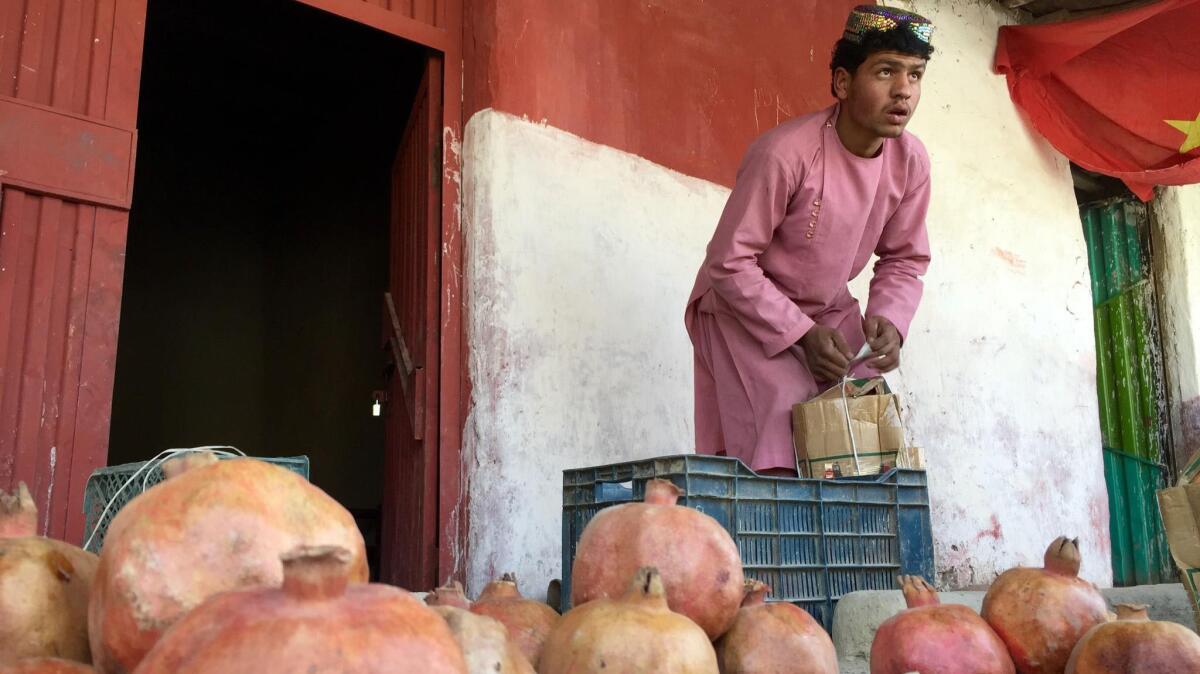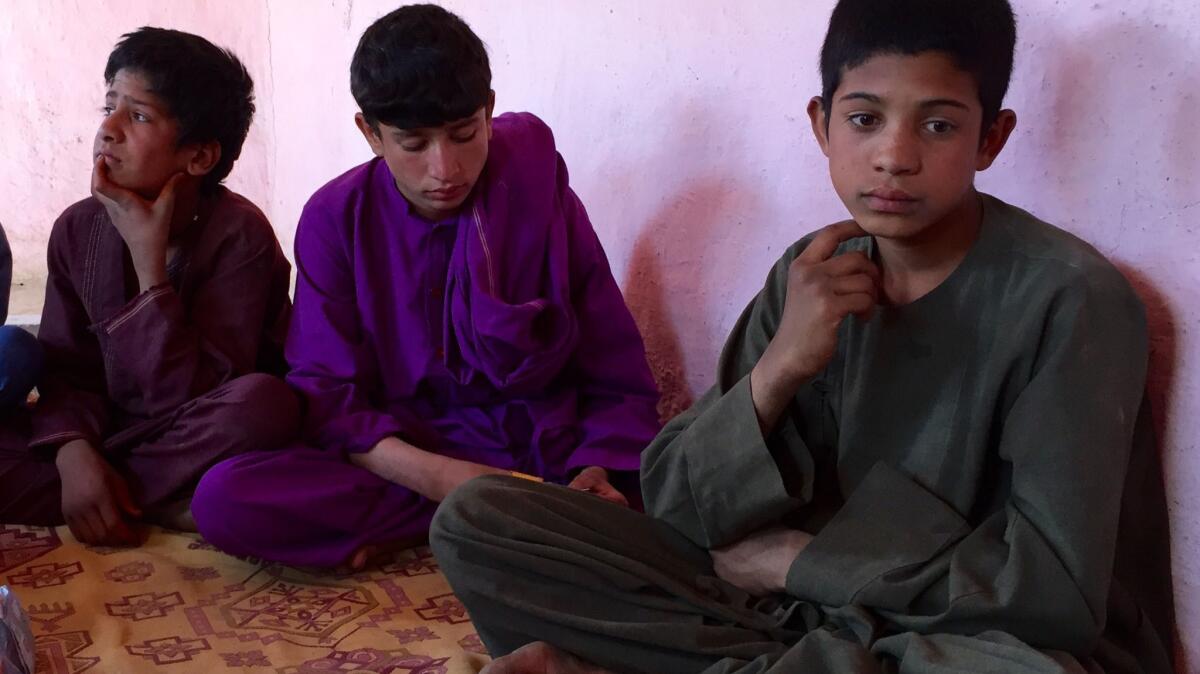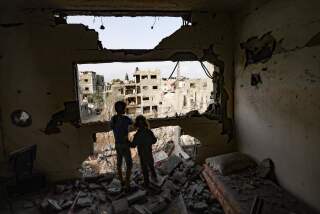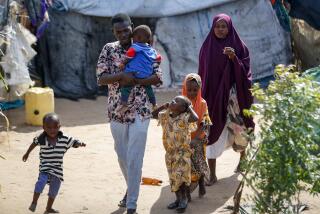These boys were born the year the U.S. invaded Afghanistan. Here’s what their lives are like today

A generation of children has grown up amid the American war in Afghanistan, which on Oct. 7 completes its 15th year.
Reporting from Kabul, Afghanistan — The young fruit-seller, buffing pale red pomegranates to a shine at a roadside stall, cannot remember a time before the war.
Mohammad Tayyeb was born the year the U.S. military stormed into his country. He does not know exactly why the foreign soldiers arrived in 2001, but when the war came to his family’s doorstep in the southern province of Helmand a few years later, they had to leave everything behind.
In the encampment for displaced people where they now live, on the fringes of the Afghan capital, Mohammad struggles to understand why a few thousand foreign troops still remain, fighting a conflict that seems to have no end. When he overhears relatives arguing or comes across television reports, he is reminded that it is not possible to go home.
“We follow the news. We see the fighting,” Mohammad said. “Every day in Helmand there is war.”
A generation of children has grown up alongside the American war in Afghanistan, which on Friday completes its 15th year. In Afghan terms that is adulthood, an age at which boys like Mohammad, who cannot afford school, must hold jobs and support their families.

His voice still cracks. The hairs on his chin emerge in wisps. Yet the $2 or $3 Mohammad earns each day selling pomegranates in the camp represents the only steady income for his parents and four younger sisters, with whom he shares a mud-walled house with a plastic roof.
The war, too, has reached an uncertain, in-between phase: From the 100,000 U.S. troops who served in Afghanistan at the height of President Obama’s surge in 2010, fewer than 9,800 remain. The figure is expected to drop to 8,400 by year’s end.
Yet violence against Afghan civilians has reached new heights as 350,000 Afghan soldiers and police prove unable to contain the Taliban insurgency. In the first six months of this year, the United Nations said, 5,166 Afghan civilians were killed or injured — nearly one-third of them children — the most since it began tracking casualties in 2009.
The U.S. military says 30% of the Afghan population now lives in areas that the Taliban either control or are threatening to seize. That has drawn American commandos and warplanes back into the fighting.
In August, U.S. military advisors deployed to Helmand, a province of fertile valleys and poppy fields, when the capital of Lashkar Gah was close to falling to the Taliban. It raised bitter memories for coalition forces, which suffered more fatalities in Helmand than any other province.
Nowhere was deadlier for U.S. troops than Sangin, where Mohammad’s family is from. The river town 60 miles northeast of Lashkar Gah is one of the world’s most important markets for opium, the Taliban’s key source of funds. British forces and U.S. Marines were first sent there in 2006 and would eventually lose at least 176 service members in combat.
Mohammad recalls little about the start of the fighting; he was 5 or 6 years old then. The family had a spacious house near the center of Sangin, where his father farmed wheat and corn. One day an explosion caused one of the walls to collapse.
They escaped with their cattle to the outskirts of Lashkar Gah, but when the fighting followed them they packed a few belongings into a taxi and sought shelter in Kabul, 300 miles away.
More than 1.2 million Afghans are refugees in their own country, on top of 2.6 million who have fled across borders. The largest camp for them in Kabul is Charahi Qambar, where Mohammad’s family now lives. The camp is a sea of squat dwellings rising from a stretch of former farmland at the city’s western edge.

Nearly 1,000 families have sought shelter here, most of them ethnic Pashtuns from Helmand. Like the more than 40 refugee settlements across the city, it has taken on an air of permanence, mud walls and sheet-metal roofs gradually replacing tents and plastic sheets.
Mohammad, who has a broad nose and curly dark hair, sits at his fruit stall along the main road into Kabul. He watches cars file past and thinks about where people are headed, what jobs they hold.
He dreams of a city job of his own.
His family was uprooted from Helmand before he could attend school, so the first time he sat in a classroom it was in the camp. Under a dull gray tent stamped with a United Nations logo, he studied in the dirt with children younger than him.
He got two years of basic education, provided for free by relief agencies. By then he was 13. When he tried to enroll in the third grade at a government school, he was rejected as too old.
He can barely read or write. On rare trips into the city, he wanders amid inscrutable street signs and unfamiliar faces, trying to find an office, a doctor, a bathroom.
Once, when he needed a pill for a headache, he spent four hours searching for a particular drugstore.
“I hate always having to ask people for help,” he said. “I have eyes but I am blind.”
There’s an English course he’s seen advertised that charges about $3 a month. One evening he worked up the courage to mention it to his parents.
If you can afford it, they said, go ahead.
But there were seven people to feed at home, and a winter to prepare for. The season is unforgiving in the refugee camps, where heavy snow collapses the makeshift roofs, and firewood, the main heating source, grows scarce.
Four years ago, at least eight people died in Charahi Qambar due to cold. Mohammad’s family burned through their firewood and slept in their jackets to make it through the nights.
He calculated that school, for now, was a luxury.
“Winter is hell for us,” Mohammad said. “I have to do everything for my family so we can survive that.”
They get little help from the outside world. Because the Kabul camps are viewed as temporary, relief agencies provide few services. Community leaders say the government denies aid to the camp because it doesn’t want to encourage new arrivals and views the Pashtuns from Helmand with suspicion, fearing they maintain ties to the mainly Pashtun Taliban.
“The government and the Americans suspect us of being with the Taliban because we have beards, wear turbans and look like them,” said Noor Mohammad, a 35-year-old elder from Sangin. “But if we go back to Helmand, the Taliban will view us as government collaborators because we lived in Kabul.”
Wakil, an impish 14-year-old from Sangin who has only one name, was born two months after the U.S.-led invasion, on the day Hamid Karzai was sworn in as Afghanistan’s interim president. They escaped to Charahi Qambar eight years ago, after roadside bombs killed their neighbors.
He earns money by polishing shoes and helped his father last year build the mud walls of their home. But every time it rains, he said, they have to make repairs.
Sometimes his father talks about returning to Helmand, which makes Wakil’s wide eyes brighten.
“We could go back to our good life,” he said. “It would be much better to work on our own land. I wouldn’t have to polish shoes.”
But one of his uncles has a small TV, powered by a car battery. Wakil sees the news from Helmand is not encouraging.
The Taliban hold or are contesting control of nearly all of the province’s 14 districts. Over the last two weeks, the insurgents have surrounded Sangin and clashed with police defending the town, killing or wounding dozens of officers, local officials said.
Seated next to Wakil, 15-year-old Qasim rubbed his right thumb, wrapped in an orange bandage. The night before, a fight had broken out in the camp. Two children were playing marbles when the adults in their families got into an argument that escalated into punches and stone-throwing.
A dozen men were sent to the hospital and several others were arrested. Boys ended up with scrapes and bruises.
“There are some rivalries in the camp,” said Qasim, the ninth of 10 children. The Pashtuns sometimes clashed with other ethnic groups, he said.
Noor Mohammad shook his head as he recounted the fight.
“No schools, no jobs – that’s why they fight,” he said. “If these children grow up to become robbers or rebels, who will be responsible? There is a dark future waiting for them.”
Mohammad’s father was among those injured. Filling cardboard boxes with pomegranates, the boy scanned the roadside for customers, hoping to sell a few extra pounds so he could take food to the hospital.
He pulled a battered cellphone from his pocket. It wasn’t connected to a network; he used it only to play music, his one indulgence.
A local singer, a sometime performer on Afghan television, had taught him traditional Pashto love songs. Some nights Mohammad sings with his cousins from Sangin, one playing a reed organ, another strumming the Afghan lute known as the rabab.
The lyrics of a favorite song correlate little to his life in the camp. Perhaps that is why, closing his eyes, he sings it:
My mother taught me love when she nursed me;
My father taught me the name of my love when I lay in his lap.
Welcome, my dreamtime,
I’m falling in love with you.
Special correspondent Sultan Faizy contributed to this report.
Follow @SBengali on Twitter for more news from South Asia
MORE WORLD NEWS
East Aleppo turning into ‘another Rwanda,’ U.N. envoy for Syria warns
North Koreans perform $975 million worth of forced labor each year, report says
More to Read
Sign up for Essential California
The most important California stories and recommendations in your inbox every morning.
You may occasionally receive promotional content from the Los Angeles Times.











